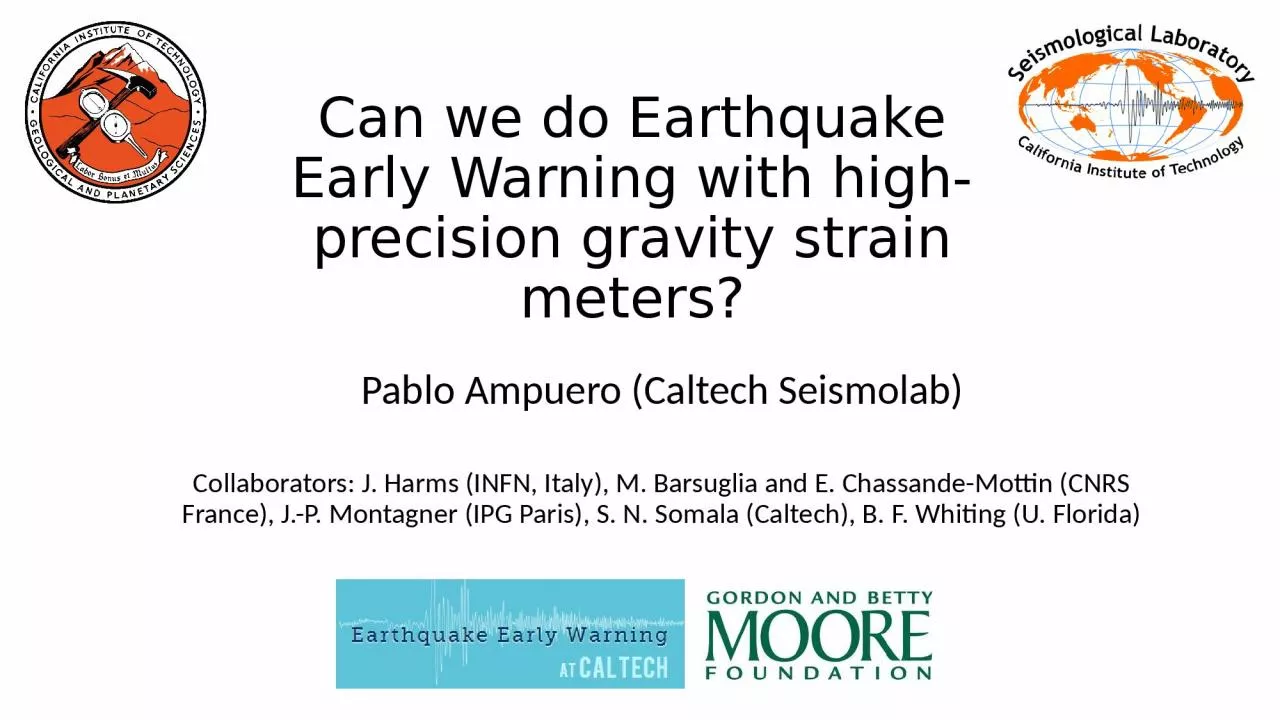

gravity strain meters Pablo Ampuero Caltech Seismolab Collaborators J Harms INFN Italy M Barsuglia and E ChassandeMottin CNRS France J P Montagner IPG Paris ID: 1025082
Download Presentation The PPT/PDF document "Can we do Earthquake Early Warning with ..." is the property of its rightful owner. Permission is granted to download and print the materials on this web site for personal, non-commercial use only, and to display it on your personal computer provided you do not modify the materials and that you retain all copyright notices contained in the materials. By downloading content from our website, you accept the terms of this agreement.
1. Can we do Earthquake Early Warning with high-precision gravity strain meters?Pablo Ampuero (Caltech Seismolab)Collaborators: J. Harms (INFN, Italy), M. Barsuglia and E. Chassande-Mottin (CNRS France), J.-P. Montagner (IPG Paris), S. N. Somala (Caltech), B. F. Whiting (U. Florida)
2. A multi-disciplinary, international collaboration: J. Harms (INFN, Italy)M. Barsuglia (CNRS France)E. Chassande-Mottin (CNRS)J.-P. Montagner (IPG Paris)S. N. Somala (Caltech)B. F. Whiting (U. Florida)
3. OverviewEarthquake Early Warning Systems: current principles and limitationsGravity perturbations induced by earthquakesGravitational Wave detectors: current and future capabilitiesPotential capabilities of an EEWS based on gravity sensorsMainly based on:Harms, Ampuero, Barsuglia, Chassande-Mottin, Montagner, Somala and Whiting (2014), Prompt earthquake detection with high-precision gravity strain meters, manuscript submitted to J. Geophys. Res., available at http://web.gps.caltech.edu/~ampuero/publications.html
4. magnitude M6.5magnitude M7.0Why do we need Early Warning ?Expected ground shaking in the Los Angeles basin,if we had an earthquake ofBöse et al., in prep.4Los Angeles Probabilities of events that would cause at least strong shaking (MMI≥VI) in the Los Angeles basin
5. San Andreas FaultS-P timeP-WaveS-WaveWhat is Earthquake Early Warning ?ability to provide a few to tens of seconds of warning before damaging seismic waves arrive5
6. JapanTaiwanMexicoTurkeyRomaniaItalyGreeceIndiaOperational systemsSystems under developmentWhere is Early Warning used ?CaliforniaEarthquake Early Warning Demonstration System
7. Public Alert warn people to take protective measures (drop-cover-hold on)move people to safe positionsprepare physically and psychologically for the impending shaking How can we use Early Warning ?Trigger Automatic Responsesslow down/stop trains control traffic by turning signals red on bridges, freeway entrancesclose valves and pipelinesstop elevatorssave vital computer informationLimitations: chance of false/wrong alerts: need to account for finite rupture sizeno warning in blind zone (~30 km around epicenter)7
8. ANTS - Pablo Ampuero - Caltech Seismo LabFaultArrays Networked to Track SourcesMultiple small-aperture arrays with overlapping fields of view covering a set of faultsExploit high-frequency waves (10 Hz) to achieve high resolution of rupture processesa network of high-frequency seismic arrays that will image large earthquakes with 10-fold better resolution than current seismic networks
9. The blind zone of an EEWSBlind zone = region close to the earthquake epicenter where damaging waves arrive before the warning is declaredSize of the blind zone = distance travelled by S waves at the time the 4th seismometer detects shaking + signal processing time + communication delaysCan we use geophysical signals that travel faster than seismic waves?Blind zone size in California (Kuyuk and Allen, 2013)
10. Static gravity changes induced by earthquakesGRACE / GOCE satellite mission have measure gravity changes after vs before large earthquakesThose are STATIC gravity changesMention Kamioka superconducting gravimeterMatsuo and Heki (2011)
11. Dynamic gravity changes induced by earthquakes: theoryGravity perturbation (acceleration) is related to a potential that satisfies a Poisson’s equation The density perturbation induced by the seismic deformation isAssume point-source earthquake in an infinite elastic medium (ignore free surface effects): use known analytical solutions for the induced seismic displacement field
12. Dynamic gravity changes induced by earthquakes: theoryWe find that the perturbation of the gravity potential isDistance Radiation pattern Double integral of seismic moment Gravity strain acceleration:
13. Verification: comparison to numerical simulationhttp://geodynamics.org/cig/software/specfem3d/ We implemented finite kinematic sources and computation of gravity field in the 3D spectral element program SPECFEM3DWe find that errors are smaller than 5%
14. Verification: comparison to numerical simulationhttp://geodynamics.org/cig/software/specfem3d/ We implemented finite kinematic sources and computation of gravity field in the 3D spectral element program SPECFEM3DThe signal decays as , as predicted, even for dipping faults
15. Earthquake spectra compared to gravity sensitivity Gravity strain acceleration:Relation to moment rate function:Epicentral distance = 70 km
16. Gravitational wave detectorsDevices designed to measure gravitational waves, minute distortions of space-time that are predicted by Einstein's theory of general relativityGW: new way to study the universeEx: VIRGO, LIGO projects to observe GW of cosmic origin(Laser Interferometer Gravitational-Wave Observatory)
17. Gravitational wave detectorsTOBA concept (torsional bar antenna)Devices designed to measure gravitational waves, minute distortions of space-time that are predicted by Einstein's theory of general relativityEx: TOBA
18. Gravitational wave detectorsTOBA concept (torsional bar antenna)Devices designed to measure gravitational waves, minute distortions of space-time that are predicted by Einstein's theory of general relativityEx: TOBA
19.
20. Earthquake spectra compared to gravity sensitivity Gravity strain acceleration:Relation to moment rate function:Epicentral distance = 70 km
21.
22. Signal to noise ratio
23. Shortest period resolved
24.
25. Optimal matched filter detection (with prewhitening)Preliminary
26. ConclusionsMultidisciplinary research, from fundamental to applied, from paper-and-pen to high-performance-computing and instrument designNext generation GW detector technology can be useful in Earth science: potential contribution to Earthquake Early Warning SystemsAdvantage over other EEWS approaches: reduces the blind zone Earthquake warning sooner and for allTo do: develop signal detection pipeline and demonstrate its capabilitiesPropose an optimal systemTheory: incorporate free surface effects, etc